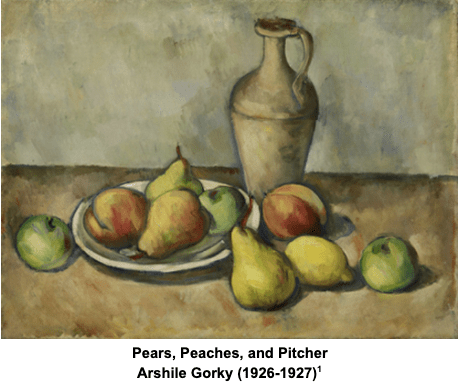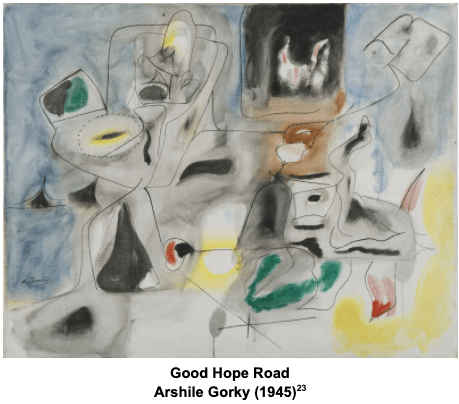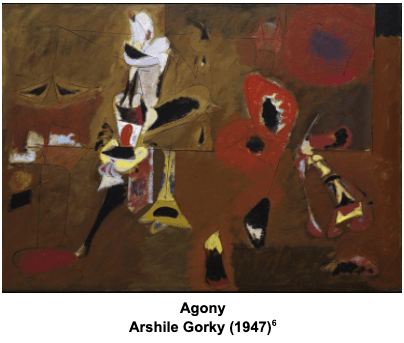Arshile Gorky and My Journey Towards Understanding Abstract Art
by Nada Elshafey
How I was first introduced to abstraction is all a blur to me. I’ve never really formulated an opinion about abstraction. I believe I was so worried about having to interpret it that I intended to always gloss over the topic once it’s mentioned. I remember hearing the word “Tagredi” (Tagredi _ تجريدى ; abstract in Arabic) every time someone doesn’t understand what they’re looking at. Tagredi was often brought up when the guy saying it feels like they’re the only one in the room that doesn’t get it. He throws it in there to divert the attention away from him. To seem cool and sophisticated just like his counterparts.
For me, Tagredi didn’t mean abstract. It meant “it’s your time to be terrified”. I grew up terrified of saying the wrong thing. Back then, If I wasn’t 101% sure of the answer, I wouldn’t participate. “Is that the right thing to say?” was my top thought whenever I opened my mouth to speak in an academic atmosphere. Art felt the same.
Just like the painting’s name suggests, there are 4 pears, 5 peaches, 1 pitcher, and a plate. The only thing you might disagree with me about is the number of pears and peaches. Some of the figures do look like both fruits, not gonna lie. But you won’t go out of your way declaring that you see a fireplace in this picture. Sure the number of pears to peaches might signify a meaning, or this could all just be a still oil painting of how Gorky’s dining table looked after dinner. But the point is, what I’m describing here will always be what we all see. No hidden objects, no scribbly lines that look like a sidewalk and a hippopotamus at the same time. No chance of getting it wrong.

“No chance of getting it wrong” was my perfect scenario, so believe me when I say I was bummed to see this painting on my first day of art history class in the NYU program. Followed by our instructor telling us to write a description about how we see it. No context provided, no history, name, or intention known. This was the first time I had to really look at the abstract. I had to quit the “glossing over”, quit the “I’ll scroll by fast as if I haven’t seen it”, and really attempt to interpret it in my own way.

This is what I wrote:
Watery pigments of light blue and black abundantly wash over the painting, They’re mixed with grey which dulls their tones. In contrast, specs of vibrant red, green, brown, and yellow, similar to those you’d see decorating a child’s painting in art class, are brushed over the page.While these tones are on opposite sides of the spectrum, some being cold colors while others being very warm and vibrant, black line-art connects them together into shapes interpreted differently by whoever might look at them.
The first two minutes of looking at it had me in a rollercoaster of thoughts. First with the famous “what am I even looking at?”. Followed by “It’s so grey” then, “It’s ugly”. “Why did he choose to make it so translucent?”. “Oh wait! These yellows and greens are vibrant.” “Maybe there’s a connection between the abundant dullness and the occasional pop of color?”
For the first time ever, I actually felt like I might have something to say about abstraction. And now that I’m looking at what I wrote, I see how I still ran away from indicating my exact interpretation and ended it with a classic fact: everyone would interpret the painting differently.
And then, it hit me! “Everyone would interpret the painting differently”. It makes no sense for me to be terrified of Tagredi because there’s no wrong answer. Abstract art doesn’t jump out and declare “THIS is what I’m all about.” Instead, abstract art requires you to have an open, inquiring mind; you must enter the painting and see where it takes you. It’s meant to be open to interpretation.
It makes sense that Arshile Gorky, the artist of the past two paintings, shifted his style to surrealism and abstraction at the time that he did. Abstract art is all about conveying emotions and feelings. Most of it is artists acting on impulse, and Gorky went through tragic, devastating events that he would then express through paintings such as “Agony”. Gorky had experienced a fire that destroyed more than 20 of his paintings, quickly followed by a painful cancer operation. Then, a car accident that broke his neck and temporarily paralyzed his good hand, and finally the disintegration of his marriage.

As many people as Gorky’s artworks must have inspired, they also acted as the medium I explored in my journey towards understanding what abstraction is about. Tagredi is not a word to use when you don’t understand the painting. It’s a word to use as you assign your own meaning to what you see.